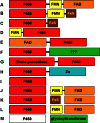Unusual cytochrome p450 enzymes and reactions
- PMID: 23632016
- PMCID: PMC3682512
- DOI: 10.1074/jbc.R113.462275
Unusual cytochrome p450 enzymes and reactions
Abstract
Cytochrome P450 enzymes primarily catalyze mixed-function oxidation reactions, plus some reductions and rearrangements of oxygenated species, e.g. prostaglandins. Most of these reactions can be rationalized in a paradigm involving Compound I, a high-valent iron-oxygen complex (FeO(3+)), to explain seemingly unusual reactions, including ring couplings, ring expansion and contraction, and fusion of substrates. Most P450s interact with flavoenzymes or iron-sulfur proteins to receive electrons from NAD(P)H. In some cases, P450s are fused to protein partners. Other P450s catalyze non-redox isomerization reactions. A number of permutations on the P450 theme reveal the diversity of cytochrome P450 form and function.
Keywords: Cytochrome P450; Enzyme Catalysis; Enzyme Mechanisms; Flavin; Heme; Natural Products; Oxidation-Reduction.
Figures




Similar articles
-
Biological diversity of cytochrome P450 redox partner systems.Adv Exp Med Biol. 2015;851:299-317. doi: 10.1007/978-3-319-16009-2_11. Adv Exp Med Biol. 2015. PMID: 26002740 Review.
-
Mechanisms of cytochrome P450 substrate oxidation: MiniReview.J Biochem Mol Toxicol. 2007;21(4):163-8. doi: 10.1002/jbt.20174. J Biochem Mol Toxicol. 2007. PMID: 17936929 Review.
-
Efficient heterologous expression of cytochrome P450 enzymes in microorganisms for the biosynthesis of natural products.Crit Rev Biotechnol. 2023 Mar;43(2):227-241. doi: 10.1080/07388551.2022.2029344. Epub 2022 Feb 6. Crit Rev Biotechnol. 2023. PMID: 35129020 Review.
-
Expression, purification, and characterization of Bacillus subtilis cytochromes P450 CYP102A2 and CYP102A3: flavocytochrome homologues of P450 BM3 from Bacillus megaterium.Biochemistry. 2004 May 11;43(18):5474-87. doi: 10.1021/bi035904m. Biochemistry. 2004. PMID: 15122913
-
Complex reactions catalyzed by cytochrome P450 enzymes.Biochim Biophys Acta. 2007 Mar;1770(3):314-29. doi: 10.1016/j.bbagen.2006.07.003. Epub 2006 Jul 13. Biochim Biophys Acta. 2007. PMID: 17239540 Review.
Cited by
-
The application of synthetic biology to elucidation of plant mono-, sesqui-, and diterpenoid metabolism.Mol Plant. 2015 Jan;8(1):6-16. doi: 10.1016/j.molp.2014.12.002. Epub 2014 Dec 11. Mol Plant. 2015. PMID: 25578268 Free PMC article. Review.
-
Introduction: Metals in Biology: α-Ketoglutarate/Iron-Dependent Dioxygenases.J Biol Chem. 2015 Aug 21;290(34):20700-20701. doi: 10.1074/jbc.R115.675652. Epub 2015 Jul 7. J Biol Chem. 2015. PMID: 26152720 Free PMC article. Review.
-
Diverse Metabolic Capacities of Fungi for Bioremediation.Indian J Microbiol. 2016 Sep;56(3):247-64. doi: 10.1007/s12088-016-0584-6. Epub 2016 Apr 23. Indian J Microbiol. 2016. PMID: 27407289 Free PMC article. Review.
-
Characterisation of the Self-Sufficient Cytochrome P450 CYP116B234 From Rhodococcus globerulus and Its Suggested Native Role in 2-Hydroxyphenylacetic Acid Metabolism.Microb Biotechnol. 2025 Mar;18(3):e70125. doi: 10.1111/1751-7915.70125. Microb Biotechnol. 2025. PMID: 40056075 Free PMC article.
-
Novel advances in biotransformation and bioactivation research - 2020 year in review.Drug Metab Rev. 2021 Aug;53(3):384-433. doi: 10.1080/03602532.2021.1916028. Epub 2021 Jun 24. Drug Metab Rev. 2021. PMID: 33910427 Free PMC article.
References
-
- Macdonald T. L., Zirvi K., Burka L. T., Peyman P., Guengerich F. P. (1982) Mechanism of cytochrome P-450 inhibition by cyclopropylamines. J. Am. Chem. Soc. 104, 2050–2052
-
- Okazaki O., Guengerich F. P. (1993) Evidence for specific base catalysis in N-dealkylation reactions catalyzed by cytochrome P450 and chloroperoxidase. Differences in rates of deprotonation of aminium radicals as an explanation for high kinetic hydrogen isotope effects observed with peroxidases. J. Biol. Chem. 268, 1546–1552 - PubMed
-
- Ortiz de Montellano P. R., De Voss J. J. (2005) Substrate oxidation by cytochrome P450 enzymes. in Cytochrome P450: Structure, Mechanism, and Biochemistry (Ortiz de Montellano P. R., ed) 3rd Ed., pp. 183–245, Kluwer Academic/Plenum Publishers, New York
-
- Kedderis G. L., Dwyer L. A., Rickert D. E., Hollenberg P. F. (1983) Source of the oxygen atom in the product of cytochrome P-450-catalyzed N-demethylation reactions. Mol. Pharmacol. 23, 758–760 - PubMed
Publication types
MeSH terms
Substances
Grants and funding
- P30 ES000267/ES/NIEHS NIH HHS/United States
- R01 CA090426/CA/NCI NIH HHS/United States
- BB/G014329/1/BB_/Biotechnology and Biological Sciences Research Council/United Kingdom
- BB/F00883X/1/BB_/Biotechnology and Biological Sciences Research Council/United Kingdom
- BB/F002521/1/BB_/Biotechnology and Biological Sciences Research Council/United Kingdom
LinkOut - more resources
Full Text Sources
Other Literature Sources
Molecular Biology Databases

